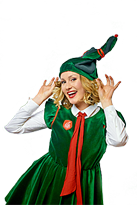Ded Moroz vs. Santa Claus: Differences and Similarities in Slavic and Western Cultures
30.10.2024
Christmas is a time filled with the tradition of gift-giving worldwide. Both children and adults look forward to special presents during this season. In Western cultures, Santa Claus is the one who delivers gifts, while in many Slavic countries, especially in Russia, Ukraine, and Belarus, this role is taken by Ded Moroz. Although both figures are tied to the winter holiday season, they differ in many aspects, from historical roots to cultural significance.
History and Origin
Santa Claus
Santa Claus has his origins in Christian tradition, based on Saint Nicholas of Myra, a 4th-century bishop from what is now Türkiye. Known for his generosity and care for the poor, Saint Nicholas became one of the most celebrated saints in both the Catholic and Orthodox Churches.
In Western culture, the image of Santa Claus evolved into a jolly, bearded man in a red suit, thanks to 19th-century literary depictions and popular illustrations by artists like Thomas Nast. Coca-Cola advertisements further solidified this iconic image.
Santa Claus - The Modern Image
In Western cultures, Santa Claus, also known as Father Christmas, has become a symbol of the Christmas spirit. This friendly old man brings gifts to children on the night of 24-25 December. Santa lives at the North Pole, where he is helped by cheerful elves who make toys in a workshop, ensuring every child receives a gift on Christmas Eve.
Ded Moroz
Ded Moroz has roots in pre-Christian Slavic mythology, associated with winter and frost. Initially, Ded Moroz was depicted as a stern, sometimes fearsome winter spirit who controlled the cold weather. However, over time, cultural shifts and various traditions softened this image, and Ded Moroz became a more benevolent figure associated with the holiday season.
During Soviet times, Ded Moroz became the central holiday character, bringing gifts to children on 31 December. His companion is his granddaughter, Snegurochka, or the Snow Maiden, who helps him distribute presents.
Differences Between Ded Moroz and Santa Claus
Appearance and clothing
Santa Claus is typically portrayed as a jolly, plump old man with a white beard, dressed in a red coat and hat trimmed with white fur. Ded Moroz is also an elderly man with a long white beard, but he wears a fur coat that can be red, blue, white, or silver, often decorated with traditional Slavic patterns. Ded Moroz’s hat is usually a tall fur cap.
Gift-giving time
Santa Claus delivers gifts on Christmas Eve, 24 December. Ded Moroz brings gifts on New Year’s Eve, the night of 31 December to 1 January. In some regions, Ded Moroz also appears during Orthodox Christmas celebrations on 7 January.
Place of residence
Santa Claus lives at the North Pole, where he works with elves to prepare toys for children. Ded Moroz resides in Russia, in a large estate in the town of Veliky Ustyug in the northwest of the country. His home has become a popular tourist destination where children can meet Ded Moroz and the Snow Maiden.
Companions
Santa Claus is often portrayed as travelling alone, sometimes accompanied by elves, but the main helpers in his journey are the reindeer that pull his sleigh. Ded Moroz, on the other hand, is never alone—he is always accompanied by his granddaughter, the Snow Maiden, and they travel together in a sleigh pulled by horses.
Similarities Between Ded Moroz and Santa Claus
Symbols of winter and Christmas
Both figures are strongly associated with winter and the holiday season. Ded Moroz and Santa Claus bring joy and gifts to children, embodying the festive spirit of the season.
Gift-giving role
Both Santa Claus and Ded Moroz play similar roles—they bring gifts to children, promoting the spirit of sharing and kindness. They embody the tradition of holiday giving and the joy of the season.
Cultural icons
Over time, Ded Moroz and Santa Claus have become cultural icons, appearing not only in folklore and traditions but also in films, books, advertisements, and other media. Their images are widely seen in holiday decorations, advertisements, and greetings cards.
Summary
Ded Moroz and Santa Claus come from different cultural and historical backgrounds, yet they serve similar roles in their communities—bringing joy to children and symbolising the holiday season. Ded Moroz is more connected with New Year’s celebrations in Slavic cultures, while Santa Claus is central to Christmas traditions in Western culture, reflecting his Christian origins.







 Your account has been set up.
Your account has been set up.